
You have a client testimonial and you know that using your client’s words in your marketing is one of the most powerful pieces of content you can create. Because your client’s stories are marketing gold dust. And by that I mean the words and phrases your clients use to explain their experience of working with your accounting firm. It’s this marketing gold dust which attracts more clients like them and can really set you apart from other accounting firms.
You can use your client’s words in your marketing to help build trust, show your expertise and attract clients who have similar problems to the ones your existing ones have. You are showing your prospects that you understand their problems and fears and frustrations and how you have helped other people who felt the same way when they came to you.
Before we get into the “hows” of testimonials, let’s clarify the differences between testimonials, stories and results:
1. By definition, a testimonial is “a formal statement testifying to someone’s character and qualifications.” In marketing, a testimonial is a client confirming their experience of working with you. They are accounting for (pun intended) your values, character, expertise and experience which you show through your marketing. Here’s one example of how you could use a testimonial:
“There are only a few things I would borrow money for, and one of those is PF. It feels like it’s business critical, not something which you fit in around the edges, but a fundamental part of changing your business.” – Georgi Rollings, owner of Starfish Accounting
2. A story is more about telling more of the client’s journey: where they started, what went right and wrong, what you did and what they did, and where they are now. And sprinkled throughout this story are golden nuggets of information to confirm your values and expertise and the way you do things at your firm. This gives the person reading it familiarity, so they’re more likely to sign up to work with you. The main focus of a story is how you have helped your client along the way, with less focus on your character and experience.
3. Results share the factual numbers, the data, the wins your client has achieved (with your help). For example, saving 23% on their overall annual expenses by forecasting their numbers better through management accounts. Results are focused on the facts, whereas stories include the reasons and the emotion. As an example, read this blog to find out more about the results our clients achieved from March 2020 to March 2021.
Share your clients stories and results in your marketing too – they are so powerful for attracting more of the types of clients who you want to work with. The best kind of marketing is showing how you have helped your clients, not sharing how wonderful you are at what you do. This will come through naturally in your clients’ stories and results.
The testimonial needs to answer a question which is being asked by your ideal audience
You’ve got a testimonial from a client. Exciting! (If you want to learn about how to get more testimonials from your clients, then read this blog). Before launching into sharing your testimonial, first ask yourself:
1. Who EXACTLY is your ideal audience? What are they like, what do they care about, why do you want to work with them?
2. Does the testimonial address a question your ideal audience has? Or, does it address a question that they WILL have, but just don’t realise it yet. It may not even be a question, but instead a doubt, a fear, a concern, a worry they have.
- If the answer is yes: great, move on to the next stage.
- If the answer is not really: if the message addresses the question, but the actual words don’t (i.e. the way your client actually said the words), redraft it and ask their permission to share the reworded version. Make sure you don’t change the message in any way.
- If the answer is no: If you feel you have helped this client solve a problem which your audience has, then go back and ask them to rephrase the message to reflect that. If you recognise that actually you don’t want more of these clients, then don’t use the testimonial. Go back to the start and think about which clients you do want more of and therefore want testimonials from to use in your marketing.
3. Does the testimonial answer a question by someone who is NOT your ideal audience?
If so, just leave it where it is (Google, Facebook etc) but don’t promote it. What you promote will be appealing to the kind of people who are like your non-ideal audience which means you’ll attract more of those.
Pick out the most powerful part of your testimonial so your prospects make their buying decision faster
The testimonial is not about you. Yes, it addresses who you are and how you helped them: but the purpose of the testimonial isn’t to brag about how great you are. Accountants often tell us how much they don’t want to appear “salesy”. Testimonials solve this for you by being helpful information so your audience can make better decisions, faster. It’s about their fears and concerns and problems and how working with you has helped resolve these. Think about:
- What problem did your client come to you with?
- How was this affecting their business, and their life?
- How did they feel about the problem?
- How did they feel about working with you at first? Did they have any doubts or worries? Were there any sticking points (particularly around pricing) which indicated deeper issues?
- How did you solve this problem?
- How do they feel after having worked with you for…?
You need to SHOW your prospects you understand them and that you have experience working with this kind of business or person. You’re saying: We understand you and here’s the proof. Don’t focus on the “nice words” they said about your firm, or you personally. This isn’t what prospects are interested in. You could be the nicest person in the world, but that doesn’t mean you have experience in applying for R&D grants for small businesses.
If you have a team, or are building and scaling your firm, it’s really important that the testimonial focuses on the whole team. Not “Sharon is so great” but “Kinder Pocock has helped me so much.” You can also include names of individuals so for example, “Kinder Pocock helped me to be more tax efficient, Sophie trained me in Xero and Fiona completed a comprehensive tax review for me.”
Here’s a quote from one our clients, PJ, owner of Force Accounting:
“Before you did my website, I had …a website. And it was out there. But what you created was an identity. You led the foundations of who we were and what we wanted to be and what we put out there, and you created a website that really lived those foundations. When I lose my way I go back to my website and look at the colours and the messages and the foundations of who we are as a firm, and it keeps me right. So it’s more than just a website you built for me.”
These are untouched, beautiful words from PJ. She has described in her own unique way, how she felt about her website and brand before. And how she feels now. It shows how PF has helped solve her problem.
Next up, focus on the keywords from the testimonial and pick out key phrases to share.
As an example, we run a feedback session after every Accelerator where we ask people what they got out of the coaching group, their victories, and what they think we could improve upon. Here was Andrew Evans’, owner of Sky Line Accounting, feedback in the session:
“I learned that it doesn’t take a lot for you to gain confidence in something. I’m also a perfectionist. These are two big stumbling blocks Accelerator has helped me overcome. It’s always a lovely end to a Thursday. I always go home feeling quite chilled, empowered, and ready to take on the world, to be honest! In the last two weeks, I’m amazed at the amount of things I’ve just started. It’s incredible. Before now, I wouldn’t have attempted them as I had a fear of not finishing them and them having too many elements to work on. I’ve made so many incremental improvements.”
There are loads of great words there, and they are all Andrew’s. The phrases which jump out are the words we, as PF, wouldn’t think to use to describe Accelerator – perhaps because it’s our coaching group and we’re trying to be “all professional” about it. But phrases like “It’s always a lovely end to a Thursday. I always go home feeling quite chilled, empowered, and ready to take on the world” are so powerful for our marketing of Accelerator. They are human and that’s why it sounds so real. Because they are real, human words. And no matter how hard we worked at it, we might never think to say it just like this, because the words are Andrew’s unique experience. Only he knows what that felt like. Only he can best describe it. That’s marketing gold dust right there.
As with all your marketing, your brand needs to show through. You’re pulling out the words which help a prospect to truly see you really are. Generic bland phrases and stock wording are really boring and won’t have any impact on a prospect. It won’t help them understand who you truly are and how this is different from the other firms they’re considering.
We’ve all seen testimonials which read like this: “Dave was a really nice guy. I’d recommend this firm to anyone.” If you look at these words on their own, the person could be talking about anyone in any industry: kitchen, joiner, restaurant. It doesn’t show your value, or their experience in working with your firm and how you HELPED them to overcome a problem they had.
Pull out the specific words and phrases that ONLY someone who truly knows you and your firm and the experience they had would be able to share. Focus on their feelings – how did working with you make them feel? What burden have you released from them? How do they feel now about their problem? If your testimonials don’t include these kinds of specifics or unique words, then you need to address how you ask for them.
Remember it’s also ok (and valuable) to include things that didn’t work out perfectly – at the start, in the middle, or whenever. It makes it real. It’s not real life to have a perfect client who had a perfect experience and nothing ever went wrong. That makes us suspicious (and rightly so) when we’re considering a company who never makes mistakes, clients who never have wobbles or concerns, projects which always go without a hitch. Share the wobbles, too: and show how you address them. How you’re not afraid to deal with problems. How you’re human, too.
As with my example above, when you share a client’s testimonial, make sure you use the client’s name, not just the name of the business and where possible, include a picture of the individual too. This will help your prospects connect personally with the story. Here’s an example from our Accelerator webpage:
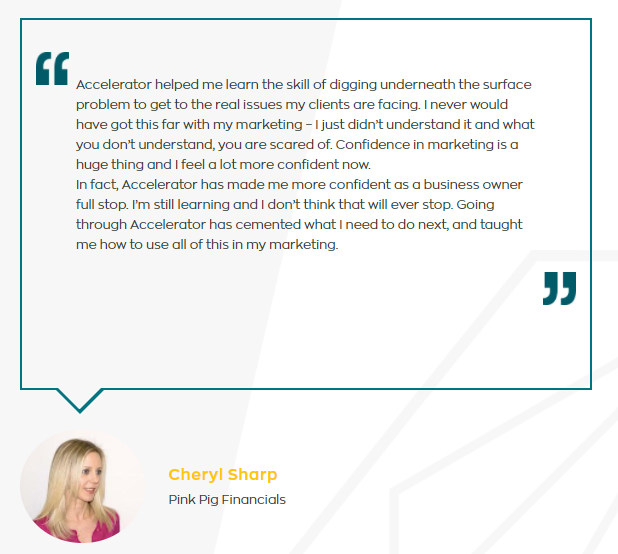
Use design tools like Canva to prepare your testimonials for sharing
Depending on how the testimonial has been sent to you (i.e. video, email, review online), this will affect how and where you share it.
Video testimonial – is the audio clear enough? Is the quality of the video good enough? Do you have a branded intro/outro you can add to the video? Do you need to edit clips out of it so it’s short enough for certain social media platforms? Use these resources to help with you with basic video editing:
Don’t feel disheartened if you asked someone to send you a video, and they did but it wasn’t quite what you were looking for. Instead consider what you have learned from the process about yourself, your client and the system you have for asking for videos. Use this as an opportunity to improve your process so that next time you ask a client for a video, it comes back just right. You can read more about what you can learn and what systems you can change when things go wrong in this blog.
- Slack message/email/online review – you can literally take a screenshot and share it on your social media (always ask for permission from your client first if it’s been sent only to you). Sometimes the rawest form of content is the most powerful. Your prospects will see that those really are your client’s words and this will speed up the buying process for prospects.
- Zoom call/in person meeting – to the best of your ability, write down the exact words your client said. If they start sharing their experience in a meeting or on a call, it’s okay to ask them to pause while you grab something to write or type on (could be a napkin or notes on your phone) and write down as many of their words as you possibly can. You can say “I love how you said that – could you repeat that for me please?”, and they’ll be glad to do so. If they aren’t sure what they just said, they’ll say it again in another way and you’ll have even more marketing gold dust. You can use these words in lots of different ways, which we’ll cover next.
Share your clients’ stories as often as you can, and make sure it’s relevant to the content you’re sharing
Website: You might think you would only include testimonials on your dedicated ‘testimonial’ page. But this content is too powerful for you to have a page that people may only stumble upon or visit. It needs to be integrated across your whole website. Have a dedicated page for your clients’ testimonials and results, but also sprinkle them throughout your website. On your services pages, include a testimonial from a client who used this exact service and has shared how it helped them. Always make sure the testimonial is relevant to the page. Don’t just add them for the sake of it.
Here are some examples of accountants doing exactly this:
Complete HQ’s Funding for Support webpage:
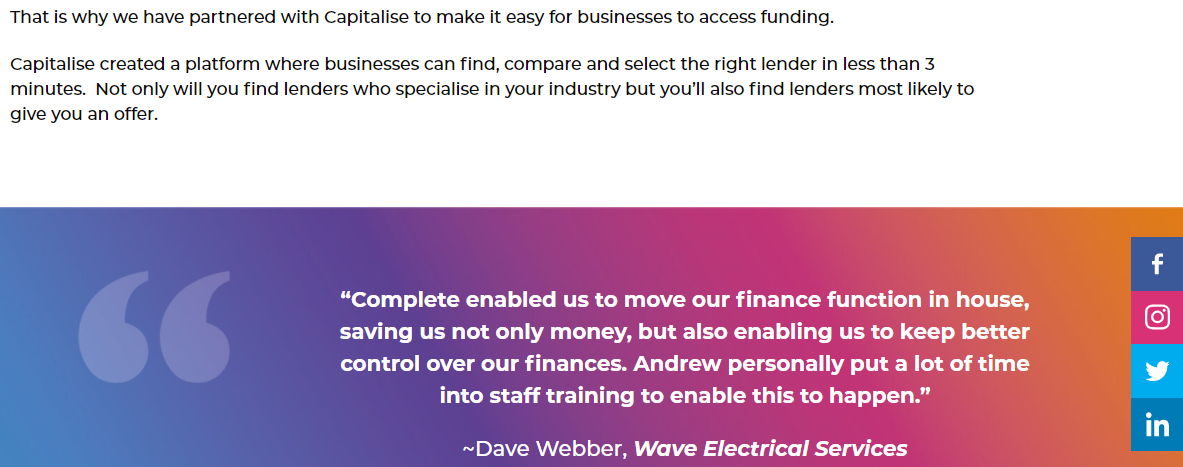
Black Sheep Accountants on their Tax Support webpage:
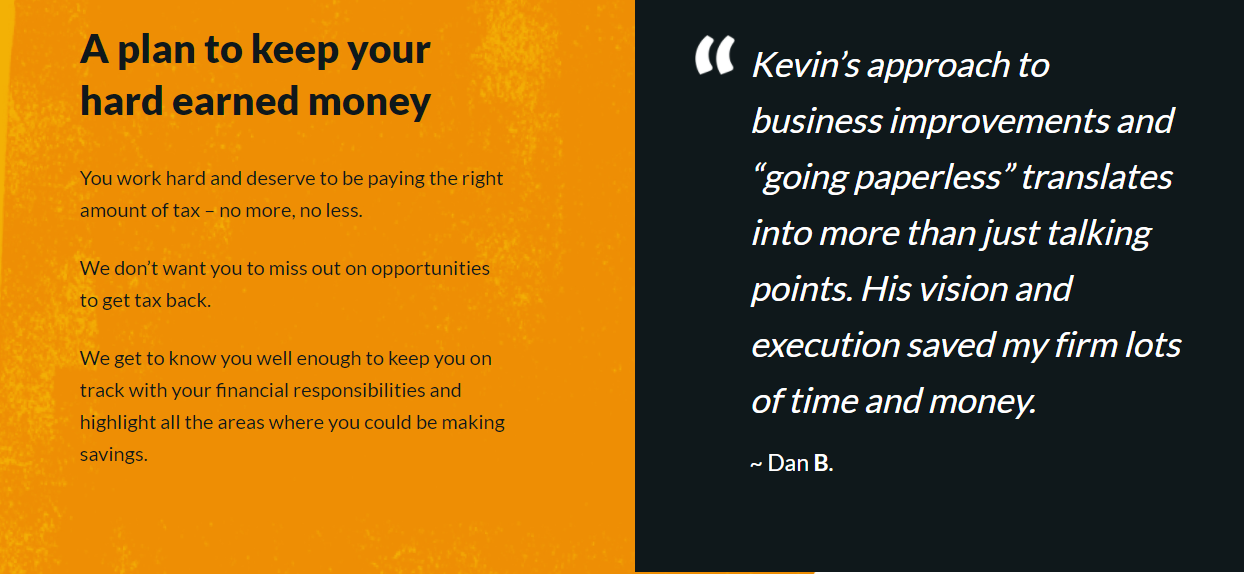
Social media: Use whichever social media platform(s) you have identified as the best place to market to your audience to share your testimonials. Create graphics using a tool like Canva and make sure you include your brand colours and fonts, your logo and the exact words your client said.
- Instagram, Twitter & Facebook: Use the most powerful words for the actual graphic and then use the remaining text in the caption. Pick out these words by reading through the whole testimonial and ask yourself “If someone could only read one sentence in this, what would it be?” These are then the words you use for the graphic. Going back to PJ’s testimonial earlier, these are the words I picked out for the actual graphic, and then used the rest in the caption:
View this post on Instagram
- LinkedIn: if it’s a written testimonial, post all the words and include a background story about the client and their business. If you have a video, upload the video natively to LinkedIn and then add an SRT file to include subtitles. Here’s an example you can use.
- Communities: Encourage your clients to share their testimonial with your community, whether that’s on Slack or Facebook or somewhere else. This is extremely powerful in your marketing. It shows prospects that the client’s words have really come from them, and they are happy and willing and excited to share the experience they had with you. Here’s a testimonial one of our clients Max posted in our Facebook PF Marketing Community:
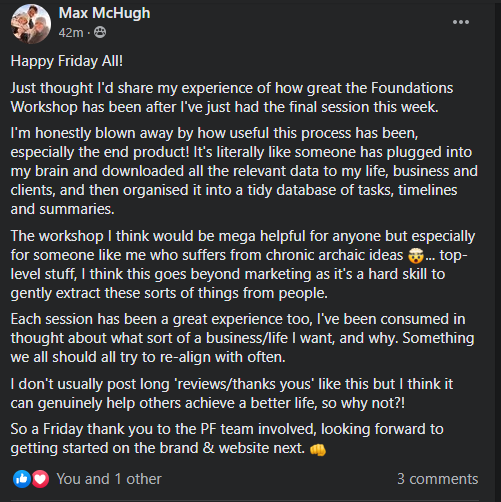
Blog posts: We encourage all accountants to write blog posts which address the questions and issues your audience have (you can read more about this here). You’ll often be addressing issues which your current clients had before they came to you which you have now helped them solve. Make sure to include testimonials from these clients when writing your blog posts.
Proposals: Have a custom testimonials page designed for your proposals document and update it as often as you need to. If you need help with this, book a discovery call with myself to discuss your custom proposal pages.
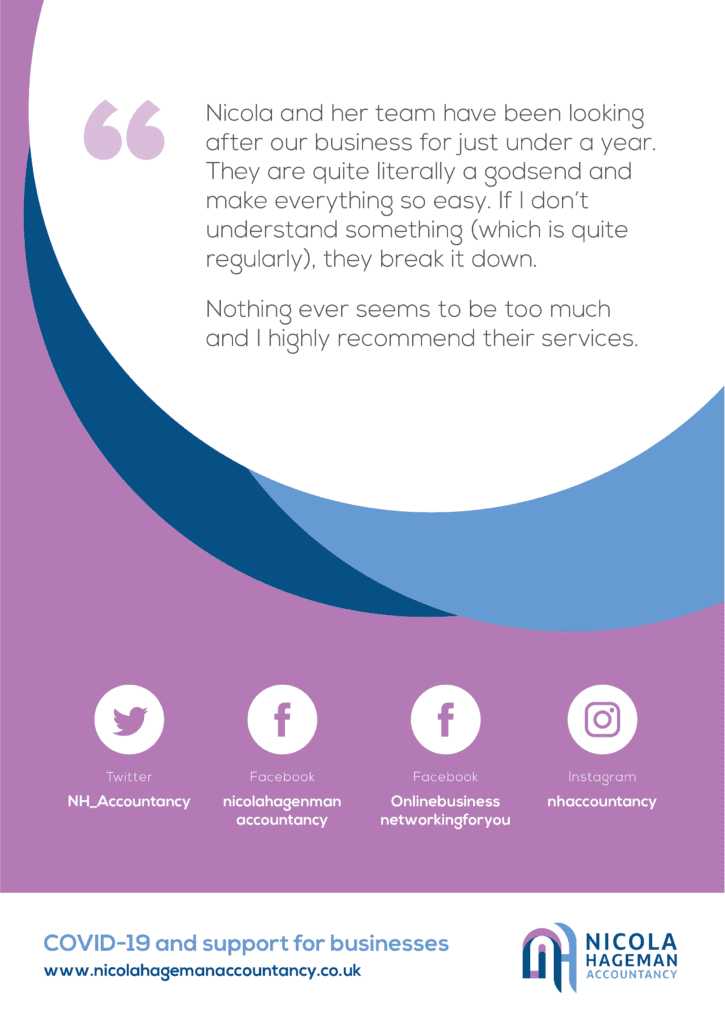
Monthly emails and newsletters:
- If you have a database with prospects, these people have already shown an interest in your firm and your services, so reading success stories from other clients you’ve helped will speed up their buying decision.
- Even if your email database only consists of existing customers, this is an opportunity to build your relationship and trust with them and they’ll be more encouraged to buy additional services from your firm.
PDF guides: As you’ve done with blog posts, scatter testimonials within your guides, welcome booklets, manifestos. Always make sure the testimonials are relevant to the page it’s on. Designer CPA included a ‘Who we work with’ page in their manifesto which features quotes from clients sharing why they used Designer CPAs services:
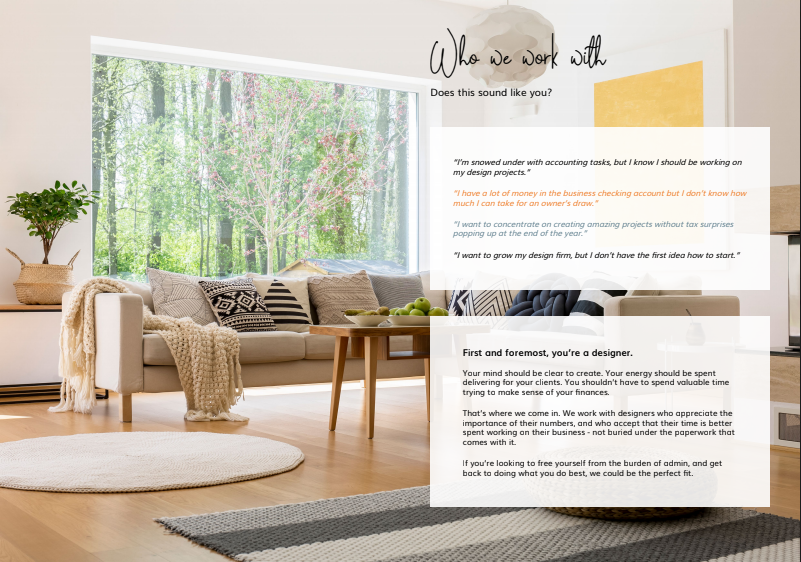
Live and online events: Sharing your clients words in your presentation, or even better a video of them, is a powerful way to connect with either an online or in-person audience. It enables you to focus your presentation on HOW you have helped people, and that makes for the best marketing.
Once you’ve got a testimonial which addresses the issues and problems your ideal audience has, and SHOWS how you helped solve them, you need to share them as much as possible in your marketing. If you aren’t sure who your audience is, or the issues they are facing, join our 12-week content marketing coaching group and learn how to determine both of these first so all of your marketing speaks to only them (and sends everyone else away).
For practical help on how to design images in Canva and how to create testimonials for your firm, join the PF Lab and get free access to these training sessions plus all the others.
Now start sprinkling your marketing gold dust!

